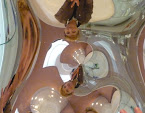On the train in to Central Station, I’d been reading Cinema Eden - a selection of essays by my favourite novelist Juan Goytisolo. When I say ‘favourite novelist’ I mean it. I don’t read many novels but I adore Juan Goytisolo’s prose. I like his critical writing, his novels, memoir - all of it. Since I first read Landscapes After The Battle in the late 1980s I have read everything he has written that I could find translated into English.

Anyway, after bombing out (or, at any rate, feeling that way) of my late-morning interview at the Arts Ministry, I decided, perhaps inspired by Juan Goytisolo’s small book, to uplift my general engagement and, hoping for cultural enrichment, to walk down to the Art Gallery of NSW to see The Arts of Islam.
But, after leaving my coat and bag at the hat check, I decided to have a look at the current Anselm Kiefer exhibition first. I’ve seen individual pieces by Anselm Kiefer before and when my partner, Jane Zemiro, and I were in Berlin some years ago we visited his ‘library installation’ at the Hamburger Bahnhof.
At the NSW Art Gallery the Kiefer artworks are strewn, Sydney-style, across various locations. As you leave a down-escalator you are sort of thrown onto a wall with a large truncated concrete staircase that was, according to the wall-didact, inspired by an Ingeborg Bachmann poem. This powerful work seems incidental to the traffic of “art-lovers” looking for the toilet or heading to another show, and the same goes for the rest of the installation. It feels, slightly horribly, a bit like an undisciplined circus. Kiefer’s interpretative sculptures of three of classical mythology’s goddesses are placed like decorative objects in a touristic pot-pourri shop right next to the cafeteria - in fact, they seem to be in the cafeteria as the staff clatter around them with food and drinks on trays and are stopped to answer location queries by lost “art-lovers”. The fallen palm-tree that accompanies Kiefer’s analysis or quest of the relationship between a fecund earthy field and its dire heavenly aspirations lies in the busy corridor between his large wall panels and a show on Picasso-et-al and modernism. Perhaps the curator here sees this possibly obstructive representation of Palm Sunday, and Jesus Christ's triumphal entry into Jerusalem, as belonging somewhere between modernist abstractions and passageway crowd management. Frankly, no matter what you think or feel about Kiefer’s work, the Art Gallery of NSW’s presentation of this sombre and serious artist is risible.

Installation at White Cube Gallery, U.K.
Seeing Anselm Kiefer’s large installation in Berlin was an utterly different experience. There, you could take this artist seriously. And you could surrender to his investigative art, whether bleak or wry, affected or genuine. The space was large enough, quiet enough (no cafeteria or bookshop within cooee of the artworks) to respond in whatever way you wanted.

Library installation (detail), Anselm Kiefer. (Foto - Pierre Joris)
Berlin's Museum for contemporary art opened in the former railway station, Hamburger Bahnhof, in November 1996. This gave the Nationalgalerie (National Gallery) the first permanent home for its collection of contemporary art.

The Hamburger Bahnhof was built 1846/47 in late classicist style. It is the only old terminal station building remaining in Berlin. For forty years it served as the terminal between Hamburg and Berlin until it was closed in 1884. And (already) in 1906 it was found to be too small for a station and was converted into a museum of traffic and building. Located in "no man’s land" between East and West Berlin, the Hamburger Bahnhof remained unused after the Second World War. Successive restoration began only after the GDR handed the building over to the City of Berlin in 1984. The war-torn building was inaccessible after 1945. It stood empty for many decades and
in 1987, the Hamburger Bahnhof was assigned to the Stiftung Preußischer Kulturbesitz (Foundation of Prussian Cultural Heritage). In 1989 the competition for the conversion of the building was won by the architect Josef Paul Kleihues, a museum specialist who designed an ideal concept for the multi-functional usage of the new museum. After reconstruction and modernization the museum, as noted above, opened in November 1996. The first major exhibition followed in 1997 with works by Sigmar Polke.

Hamburger Bahnhof, Berlin
To end more positively on the riches of Wednesday, I'll direct The Deletions' visitors to Peter Campbell's article on these Palm Sunday works by Anselm Kiefer in the LRB earlier this year, and also say that the exhibition of the arts of Islam is excellent in spite of the expected and traditional absence of women (apart from two images - in a Maghrebi and an Afghani miniature) and even if this avid “art lover” had to crick and crane to read the poorly placed labels.


No comments:
Post a Comment